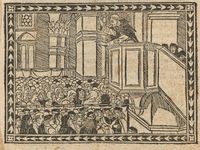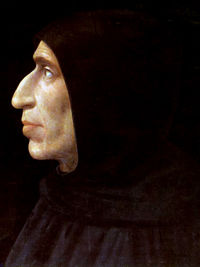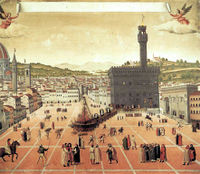How did Savonarola influence the Reformation and Counter-Reformation
Girolamo Savonarola, (1452- 1498), was an Italian preacher and theologian, who sought to reform the church and society in Florence and Italy. He became renowned throughout Italy after his attacks on the immoral and the corrupt clergy and his criticism of the ruling elite in Florence. After the overthrow of the Medici in 1494, Savonarola was the most influential figure in Florence, even though he never held office. His power was short-lived, and he ended his days on the gallows. However, he was a very important figure and was an immensely influential figure in Renaissance Italy and indeed Europe. This article will show that Savonarola was a key figure in the development of both the Reformation and the Counter-Reformation. Uniquely, he was to inspire figures such as Martin Luther and other leaders of the Reformation and also leading figures in the Catholic Church.
Background
Italy in the 15th century was the most dynamic part of Europe if not the world. It was a center of trade and finance and the merchants of the various city-states were laying the foundation for the modern capitalist system. Italy was the home to great thinkers and it was the center of Humanism, a set of beliefs that would gradually change Europe and the world. Renaissance Italy was to produce great works in literature, sculpture, painting and architecture. However, despite the wealth and the cultural achievements there was great unrest in Italy. The population was very religious, and many people were concerned with the sinfulness of contemporary society [1]. Renaissance Italy was a very stratified society where a small wealthy elite exploited most of the population who were condemned to lives of abject poverty. Then the era was one where war was constant and many city-states were disturbed by civil strife. Then there was the ever-recurring epidemics that killed countless every year. Behind the glories of Renaissance Italy, the bulk of the population lived in poverty, terror and in fear for their immortal souls. This is not the image we have of the Renaissance, but this was the case. It is only by accepting this can we understand the career of Savonarola.
Life and Career of Savonarola
Girolamo Savonarola was born in Ferrara, and from an early age was very religious and he deplored “the blind wickedness of the peoples of Italy.” [2] He detested the humanism that was popular in elite circles which he saw as a form of paganism. He was a member of the Dominican Order and was a lecturer in theology. He was deeply influenced by Medieval philosophy and in many ways, he wanted a return to the Middle Ages [3]. In 1482 Savonarola was sent to Florence here he gained a great reputation for his learning and asceticism. He claimed to have visions and these he related in his sermons, which were hugely popular. He was a fearless man and he denounced the church and he deplored its sinfulness. At first the de Medici were sympathetic to Savonarola. However, their support for him dissipated when he began to attack their rule. After the death of Lorenzo, the Magnificent the de Medici family’s grip on power was weakened mainly because of problems in their bank. In 1494 Savonarola predicted the invasion of Charles VIII of France and his string of easy victories. This won him the respect and many people in Florence regarded him as a prophet. As the French king approached the de Medici fled and the government of the city-state fell into the hands of some of the local elite [4]. Savonarola was able to become the de-facto ruler of the city because of his influence over the population. He helped to introduce a democratic government, one that was very fair and effective. Savonarola aim was to find his city of God in Florence, the heart of Italy. He sought to create a theocratic state in the heart of Renaissance Italy. He also devoted much time to reforming the Church. It is generally agreed by Savonarola’s contemporaries that the Church in Florence was a model of holiness and probity. Savonarola also tried to reform the morals of Florence and he organized the ‘Bonfire of the Vanities’ [5]. This was where the inhabitants were encouraged to burn immoral items, playing cards, ornaments and luxuries. The preacher also initiated a crackdown on vice and irreligious beliefs. However, Savonarola was making powerful enemies and they persuaded the Pope to threaten him with excommunication. The Florentine preacher then condemned the Papal Court and even the Pope. However, many in the Church continued to support the preacher and his sermons were printed and distributed widely. In 1496, the preacher founded the Congregation of San Marco. A new party took control in Florence and they were less amenable to the influence of the preacher and they even secured the excommunication of Savonarola [6]. This was illegal and even the Pope rejected it, even though he was by now the enemy of the Florentine cleric. When the new government of Florence agreed to enter the Holy League, the Pope reluctantly agreed, and the Bull of Excommunication was passed. Savonarola decided to prove himself by undergoing a ‘trial by fire’, to prove that he was innocent of the charges in the Bull[7]. However, this ended in a farce and this caused the preacher to lose support among many of his followers. The following day a mob that was organized by his enemies attacked the monastery where the preacher was staying and took him to jail. Here he was cruelly tortured to make him confess that he was a heretic. Savonarola refused to make any confession and defied his interrogators. However, his fate was sealed, and the Pope sanctioned his execution. Those who witnessed his trial in an ecclesiastical court regarded it as a mockery of justice and it was undoubtedly a show-trial [8]. On the morning of the 28th of May 1498 Savonarola along with two companions were hanged on some gallows erected in the main square in Florence. As they were being hung a fire was lit beneath their feet. Savonarola remains were scattered in the River Arno so that his followers would not be able to bury his remains. Almost thirty volumes of Savonarola's writings have been published, they consist of sermons, psalms and visions. The friars of San Marco ‘venerated Savonarola as a saint’ and they helped to keep his teachings alive[9].

Savonarola and the growth of reform ideas
The Friars of Saint Marco were repressed when the de Medici regained power in Florence. They had the last rector of the Friars hunted down and executed without a fair trial. The influence of the great Dominican was to live on. His own order especially throughout Europe revered his memory and regarded him as a saint. Savonarola religious ideas soon spread, and his writings were widely read. The growth of publishing made many of his sermons and his visions available outside Italy. His writings were very popular in Germany and Switzerland. There was a growing demand for meaningful reform of the Church and there was a sense that the Papacy was wicked and corrupt. The life and death of Savonarola inspired many in these countries and they saw him as the victim of a corrupt Pope and whose only crime was to seek the reform of the Church. He was seen by many clerics as martyr. Among those who read him was a German Augustinian monk, by the name of Martin Luther, he was deeply impressed by Savonarola. He studied the writings of the Florentine preacher declared him to be a martyr. Historians believe that the Italian friar influenced Luther, as seen in his ideas on faith and the doctrine of justification by faith alone. In France many of his works were translated and published and Savonarola came to be regarded as a precursor of evangelical reformers[10]. Savonarola had shown that it was possible to defy the Pope and that a ‘godly’ republic based on the scriptures was possible and this inspired many in the years before the Reformation. There is some debate, over whether the Italian Friar influenced Jean Calvin the founder of Calvinism. Many believe that the theocracy that was established in Geneva by Calvin was inspired in part by the example of Savonarola. The Swiss city-state was like Florence, during the supremacy of Savonarola dominated by the Church and committed to a political system that was based on the Christian scriptures.
Savonarola and the Counter Reformation
Savonarola’s memory lived on in Italy. Within the Dominican Order Savonarola was repackaged as an innocuous, purely devotional figure and he inspired many of those who led the Counter Reformation. This was an effort to revive and to reform the Catholic Church to combat the rise of Protestantism. The Catholic reformers were inspired by the example of Savonarola and his experiment in Florence[11]. He was a model for their activities. They believed that they should use their influence with the populace to help in the reformation of society and the church. The writings of the Friar were studied by many leading Catholic reformers as they sought ways to reform the Church. Despite being excommunicated and convicted as a heretic, an unofficial cult to the saint was dedicated in Rome. Several future saints were inspired by the Florentine preacher and they revered his memory. Among the saints who revered him were Saint Phillip Neri, the, founder of the Oratorians. He was a Florentine who had been educated by the San Marco Dominicans and his new order was very much influenced by Savonarola’s ideals. Another saint who was, influenced by the Florentine was Saint Catherine Ricci. It seems that Savonarola persuaded many in the Catholic Reformation that they should not only reform the Church but also society [12]. This influenced many to help the poor and the marginalized, to make society a better place. However, while Savonarola inspired many reformers they also learned from his example and did all they could they avoid his fate. The Catholic reformers worked within the Church such as Saint Phillip Neri [13]. He was a member of the Catholic hierarchy and sought to reform the Church from within. Another example of this was Saint Charles Borromeo, the Archbishop of Milan, who worked to reform both the Church and society of Milan by working within the official channels [14]. There were many who worked to create a society that was modelled on the teachings of Christ but they all made sure that they did not offend or challenge those in power. The leaders of the Catholic Reformation learned from the example of Savonarola and adopted a cautious approach so that they would not fall victim to the machinations of the powers-that-be.
Conclusion
Savonarola was a conservative and he sought to defend the traditional beliefs and morality from what he saw as the paganism of the Renaissance. In many ways he wanted to turn the clock back to the Middle Ages. In pursuit of his aims he helped to inspire a new form of government, a democracy that was inspired by Christian ideals and committed to patterning society after the teachings of the Church. His attempt failed as he simply threatened too many vested interests and his downfall was almost inevitable. However, he was an inspirational figure, a gifted writer, printing allowed his ideas and thoughts to be disseminated widely and he was to influence many. His example and his writings were influential before the Reformation and he influenced Luther and possibly Calvin. Savonarola and his example showed that it was possible to defy the Pope and to reform the Church and Society. The Florentine friar influenced many Catholic reformers. However, they did not want to share his martyrdom and as a result they made sure that they worked with the elite in the Church and the state. They had learned that reformers required the support of the elite if they wanted to succeed. Savonarola is a towering figure, he may have failed to reform Italy and the Church, but he was immensely influential on both the Reformation and the Counter Reformation.
References
- Jump up ↑ Ruggiero, Guido. The Renaissance in Italy: A Social and Cultural History of the Rinascimento (Cambridge, Cambridge University Press, 2015), p. 648
- Jump up ↑ Ruggerio, p. 649
- Jump up ↑ Polizzotto, Lorenzo "The Elect Nation; The Savonarola Movement in Florence 1494–1545" (Oxford, Oxford University Press, 1994), p. 45
- Jump up ↑ Polizzotto, p. 78
- Jump up ↑ Green, J. & Karolides. N. Savonrola, Fra Girolamo. In Encyclopedia of Censorship: New Edition (New York, NY: Facts On File, Inc. 2005), p. 495
- Jump up ↑ Green, p. 496
- Jump up ↑ Polizzotto, p. 178
- Jump up ↑ Polizzotto, p. 213
- Jump up ↑ Polizzotto, p. 78
- Jump up ↑ Weinstein, Donald "Savonarola the Rise and Fall of a Renaissance Prophet" (Fontana Press, New Haven, 2011), p. 117
- Jump up ↑ Weinstein, p. 219
- Jump up ↑ Olin, John C The Catholic Reformation: Savonarola to Ignatius Loyola: Reform in the Church, 1495–1540 (Fordham University Press, 1992), p. 201
- Jump up ↑ Olin, p. 212
- Jump up ↑ Olin, p 217


